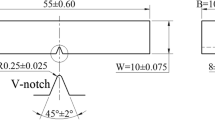Abstract
Instrumentation of the Charpy impact test permits an analysis of the data in terms of linear elastic fraeture mechanics. Measurements of time to fracture are converted to estimated crack opening displacements at fracture and thus to values of the fracture toughness parameter KC. The variation of these values with temperature shows a transition which is interpreted as a change from plane strain to plane stress fracture.
An expression is derived which relates the critical cleavage stress and the plane strain fracture toughness (KIC) and allows this latter quantity to be calculated from dynamic stress measurements in those Charpy tests which give fractures at conditions where general yield just occurs. It is noted that the values of KIC so obtained are significantly lower than the values obtained from ‘time-to-fracture’ measurements, and the differences are discussed. It is concluded that the KIC values obtained from the stress measurements are of more general interest, and the uncertainties involved in these estimates are outlined.
Résumé
À force d'instrumenter Fessay Charpy du dureté au choc on se met en position de faire l'analyse des résultats qu'il fournit en utilisant le méchanique linéar—elastique de la rupture. De la valeur du temps avant la rupture se laisse calculer approximativement l'ouverture du dout de la fissure (crack opening displacement) au moment de la rupture et de la valeur du paramètre de la résistance à la rupture, KC. La dépendence de cette valeur de la température montre une transition considérée comme changement du mode de la rupture de deformation planaire en contrainte planaire.
On développe une expression qui met en corrélation la contrainte critique du clivage et la résistance à la rupture dans les conditions de la déformation planaire et permet le calcul de cette quantité au moyen du mesurage de la contrainte dynamique dans les essais Charpy où la rupture se produit lors de l'écoulement général. On remarque que les valeurs de KIC ainsi obtenues sont d'une manière significative inférieures à celles que l'on obtient du temps avant la rupture, et les différences sont discutées. Il est conclu que les valeurs de KIC que l'on obtien en mesurant la contrainte sont d'un interêt plus général et les incertitudes qu'entraînent ces calculs approximatifs sont brièvement décrites.
Zusammenfassung
Infolge der Instrumentierung der Charpy-Kerbschlagprufüng können die gelieferten Daten durch linear-elastische Bruchmechanik analysiert werden. Messwerte der vorm Bruchvorkommen ablaufenden Zell werden zu geschätzten Rissöffnungswerten (crack opening displacements) beim Bruch, also zu Werten des Bruchwiderstandsparameters KC, umgerechnet. Die Temperaturabhägig dieser Werte zeigt einen Übergang, der nach der Deutung der Autoren einer Änderung der Bruchweise entspricht (zweiachsige Spannung wird zu zweiachsiger Verformung).
Ein Ausdruck wird abgeleitet, der die kritische Trennbruchspannung und den der zweiachsige Verzerrung entsprechenden Bruchwiderstand (KIC) in Wechselbeziehung bring und die Berechnung dieses letzten aus dynanamischen Spannungswerten bei jinen Charpy-Prüfungen ermöglicht, bei denen der Bruch gerade bei der Einstellung des weitverbreiteten Fliessens vorkommt. Es wird bemerkt, dass die so erhaltenen KIC-Werte bedeutend niedriger sind als die, die aus ‘Zeit zum Bruch’ Messwerten erhalten werden. Die Unterschiede werden besprochen. Es wird beschlossen, dass die aus den Spannungsmessungen bestimmten KIC-Werte von weiterem Interesse sind, and die mit diesen geschätzten Werten verbundenen Unsicherheiten werden kurz beschrieben.
Similar content being viewed by others
References
Irwin, G.R. Trans ASME Appl. Mech. 24, 361. (1957).
J.C. Radon and C.E. Turner J.I.S.I., 204, 842 (1966).
G.D. Fearnehough and C.J. Hoy J.I.S.I., 202, 912 (1964).
A.A. Wells Brit. Weld. J., 10, 11, 855 (1963).
F.M. Burdekin and D.E.W. Stone J. Strain Analysis, 1, 2, 145 (1966).
J.F. Knott and A.H. Cottrell J.I.S.I., 201, 249 (1963).
A.A. Wells ‘Unstable Crack Propagation in Metals,’ Crack Propagation Symp., College of Aero. and the Royal Aero. Soc., Cranfield (Sept. 1961).
T.R. Wilshaw J.I.S.I., 204, 936 (1966).
G.D. Fearnehough ‘The Strain Rate Sensitivity of the Yield Stress of Steels,’ Proc. Conf. on Yielding and Fracture, Inst. Phys. and Phys. Soc., Oxford (Sept. 1966).
A.P. Green and B.B. Hundy J. Mech. Phys. Solids, 4, 2, 128 (1956).
J.D. Lubahn Weld. J., 34, 518, S (1955).
G. Lianis and H. Ford J. Mech. Phys. Solids, 7, 1 (1958).
J.M. Alexander and T.J. Komoly J. Mech. Phys. Solids, 10, 265 (1962).
N.P. Allen, C.C. Earley, and J.H. Rendall Proc. Roy. Soc., A 285, 120 (1965).
T.R. Wilshaw and P.L. Pratt J. Mech. Phys. Solids, 14, 7 (1966).
J. F. Knott J.I.S.I., 204, 104 (1966).
T.R. Wilshaw and P.L. Pratt Int. Conf. on Fracture, Proc., Sendai, Japan (Sept. 1965).
A.A. Wells Proc. Roy. Soc., A 285, 34 (1965).
Author information
Authors and Affiliations
Rights and permissions
About this article
Cite this article
Fearnehough, G.D., Nichols, R.W. Fracture mechanics considerations in the Charpy impact test. Int J Fract 4, 245–256 (1968). https://doi.org/10.1007/BF00185260
Received:
Issue Date:
DOI: https://doi.org/10.1007/BF00185260




